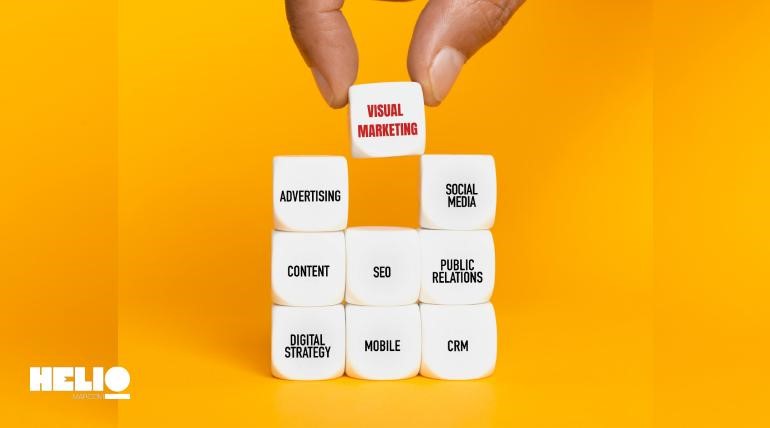In an increasingly digitized world, the battlefield for consumers’ attention is fiercer than ever. Small business owners, marketing professionals, and entrepreneurs operating in this arena must leverage every tool available to captivate and engage their audience. Among these tools, visual marketing emerges not just as an option but as an essential strategy for success.
Here, the graphics design department of Helio provides a comprehensive guide through the indispensable role of visual marketing in elevating your brand. Visual elements—images, videos, or animations—are much more than embellishments. They are a direct conduit to your audience’s emotions, enabling more effective communication of your brand’s messages and values.
In today’s fast-paced digital landscape, quickly capturing and retaining consumer attention is paramount. Strategic visual content not only distinguishes your brand from competitors but also boosts engagement rates, enhances memory recall, and increases conversions. We will explore how integrating visual marketing strategies into your communication plan can lead to a significant uptick in brand visibility, customer loyalty, and ultimately, business growth.
What Is Visual Marketing?
Visual marketing is an approach that leverages compelling imagery, videos, infographics, and other visual elements to communicate a brand’s values, story, and messages. It is a critical component of a comprehensive marketing strategy, designed to attract, engage, and convert audiences more effectively than text alone. This method exploits the human brain’s predisposition towards visual information, facilitating faster processing and better retention of messages.
Visual marketing encompasses a range of content types including social media graphics, product photography, website design, digital ads, and video content. It operates under the principle that visually appealing content is more likely to evoke emotional responses from viewers, encouraging them to take action—whether making a purchase, sharing content, or engaging with a brand on a deeper level. The strategic use of color, layout, typography, and imagery can significantly enhance brand recognition and customer recall, making visual marketing an indispensable tool in the digital age.
Why Visual Content is King in Today’s Digital Landscape?
Visual marketing harnesses the power of imagery—through photos, videos, infographics, and user-generated content—to communicate a brand’s messages and values. In the digital age, where the average consumer’s attention span is continuously shrinking, instantly connecting through visuals is invaluable. This article explores why integrating visual marketing into your strategy isn’t just beneficial; it’s imperative for growth and engagement.
Utilizing compelling visuals to tell your brand’s story is not merely about creating content that looks good. It’s about crafting messages that reflect your audience’s values, aspirations, and experiences. Each image, video, or infographic should be a chapter in your brand’s larger narrative, strategically designed to guide the viewer through a curated experience that aligns with your corporate objectives.
For businesses aiming to thrive in a competitive market, implementing visual storytelling is not a luxury; it’s a strategic necessity. Integrating this approach into your marketing strategy, can elevate your brand’s visibility, foster deeper customer engagement, and drive a more robust emotional response to your campaigns. This holistic engagement methodology sets successful brands apart in today’s visually saturated market landscape.
The Power of Visual Marketing
Humans are inherently visual creatures, with the brain processing images 60,000 times faster than text. This psychological fact underscores the influential role of visuals in shaping brand perception, enhancing engagement, and boosting conversion rates. Through strategic visual storytelling, brands can evoke emotions, convey complex information succinctly, and create memorable interactions that drive consumer action.
Types of Visual Content & Visual Marketing Examples
The landscape of visual content is as vast as it is diverse. High-quality images and videos immediately grab attention, but the richness of visual marketing extends far beyond. Infographics offer a visually appealing way to digest complex data, while user-generated content builds community and authenticity around your brand. Each type serves a purpose, contributing to a cohesive visual identity that resonates with your target audience.
Below are critical visual content types to consider in your marketing strategy:
- Infographics: These blend data and design, offering an easy-to-understand topic overview. Infographics are highly shareable and can make complex information or statistics engaging and accessible.
- Videos: Video content is incredibly engaging, ranging from short social media clips to longer, informative explainer videos. Videos are versatile, capable of conveying your brand’s message, story, or even demonstrating product use effectively.
- Images: High-quality, original images can quickly capture attention. Whether for product photography, team photos, or creative visuals, images are fundamental to making your brand visually appealing.
- User-Generated Content (UGC): Content created by your customers, such as reviews, testimonials, or photos of them using your product, lends authenticity to your brand. UGC can foster community and trust around your products or services.
- Interactive Content: Quizzes, polls, and interactive infographics can increase engagement by encouraging audience participation. This type of content not only entertains but also provides valuable insights into consumer preferences.
- Animations: Short animations or GIFs can add a dynamic element to your content. They are particularly effective in grabbing attention in email marketing, social media, or as part of website design.
- Social Media Graphics: Tailored graphics for platforms like Instagram, Facebook, Twitter, or LinkedIn can help in maintaining a cohesive brand identity. These graphics can be used to highlight promotions, share quotes, or celebrate milestones.
By integrating a mix of these visual content types into your marketing strategy, you can cater to different audience preferences, enhance message retention, and drive more significant engagement across all digital platforms. Strategic planning and creative execution in visual marketing can thus position your brand effectively in a competitive market landscape.

Crafting Your Visual Marketing Strategy; Best Practices for Visual Marketing
Developing a powerful visual marketing strategy requires a multidisciplinary approach that encompasses market research, audience understanding, creative concept development, and strategic distribution. To effectively harness the potential of visual content, consider the following steps:
- Define Your Objectives: Clearly outline what you aim to achieve with your visual marketing efforts. Whether it’s increasing brand awareness, driving website traffic, or boosting sales, your objectives should guide your content creation and distribution strategy.
- Understand Your Audience: It’s crucial to deeply engage with your target audience’s preferences, pain points, and platforms of choice is crucial. Tailor your visual content to match their expectations and meet them where they are most active, be it on social media, email, or your website.
- Create Compelling Visual Content: Prioritize quality and creativity in your visuals. Each piece of content should reflect your brand identity and message while being designed to capture attention and provoke thought or action. Utilize a mix of content types to keep your audience engaged and interested.
- Optimize for Each Platform: Different platforms have varying requirements and user expectations. Customize your visual content for each channel, ensuring it’s formatted correctly and optimized for engagement (e.g., Instagram’s visually rich environment vs. LinkedIn’s professional tone).
- Measure and Analyze Performance: Use analytics tools to track the performance of your visual content across platforms. Analyze engagement metrics, conversion rates, and audience feedback to understand what works and what doesn’t. This data-driven approach will inform future content creation and strategy adjustments.
- Leverage User-Generated Content: Encourage your audience to create and share their content featuring your brand. User-generated content not only amplifies your reach but also builds trust and authenticity, as prospective customers see real people endorsing your brand.
Crafting compelling visual content requires more than creativity; it demands a strategic approach. To begin, align your visuals with your brand identity, ensuring platform consistency. Use images and videos that complement and amplify your message, placing them strategically throughout your digital presence to capture interest and encourage interaction. Engage your audience with a mix of content types, experimenting and analyzing to find what works best for your brand.
Tools and Resources
Fortunately, creating top-notch visual content has never been more accessible, thanks to many tools and resources available online. From graphic design platforms like Canva to stock photo libraries and video editing software, these resources empower even non-designers to produce professional-quality visuals. Harnessing these tools can elevate your visual marketing strategy, distinguishing your brand in a crowded marketplace.
The Future of Visual Marketing
Visual marketing is set to become even more dominant, driven by technological advances and evolving consumer preferences. Innovations like augmented reality (AR) and virtual reality (VR) will offer new realms of immersive experience, while the continued rise of social media platforms prioritizes visual content. Staying abreast of these trends and adapting your strategy will be crucial for staying competitive.
Help Your Brand with Helio Graphics Design Department
The compelling nature of visual marketing cannot be overstated. In the fast-paced digital landscape, it is beacon for businesses looking to forge meaningful connections with their audience. By harnessing this potent tool, you can transform how your brand is perceived, experienced, and remembered.
Elevating your brand requires not just understanding what visual marketing is but mastering its application. Through strategic use of imagery, comprehensive planning, and constant innovation, your brand can shine brightly in the crowded digital marketplace. Equip your brand with the best visual marketing—start by exploring Helio graphics design—and watch your brand story unfold in vibrant color and compelling visuals.
Elevate your brand today by weaving visual marketing into the fabric of your digital strategy. The future is vivid; ensure your brand is seen and remembered.





